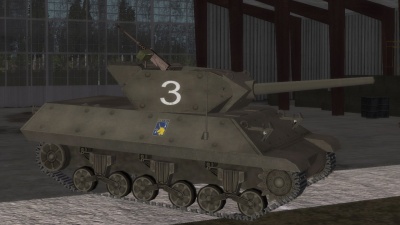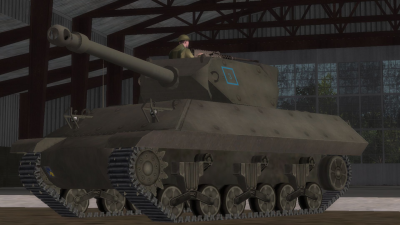M10 Wolverine
History
| Main Gun Optics | |
| Specifications | |
| Designation | M70G Telescopic |
| Magnification | 3x |
| Field of View | 12° |
American pre-war armored vehicle doctrine called for tanks to accompany infantry and attack enemy troops while a specifically-designed anti-tank reserve would engage enemy tanks. Experience soon showed that towed anti-tank guns, while inexpensive, were too immobile for the fluid realities of tank warfare. The 3 in. Gun Motor Carriage M10, the Wolverine, or in British service the 3in SPM M10 was the first purpose-built replacement for anti-tank guns mounted on a halftrack or truck chassis (so-called "portee" guns) that US divisions employed in North Africa. Based on an M4 Sherman chassis, with a lightly armored, open-top turret, the M10 was successful due to its high-velocity 3 in. (76.2 mm) gun, which was based on the 3 in. M1918 anti-aircraft gun. Despite formal doctrine, the practicalities of combat usually meant that Wolverines generally served as general-purpose light tanks with extremely potent guns.
This vehicle is forever associated with Audie Murphy, the most decorated US soldier of World War II, who earned his Congressional Medal of Honor by holding off a German force of tanks and infantry by resolutely manning the 50 caliber machine gun atop a burning M10.
Game Play
The M10 is most successful when it’s used precisely as it was designed – as a motor carriage mounting an excellent anti-tank gun. Despite its tank-like appearance, it is not capable of trading sustained fire with enemy tanks. It has relatively thin armor that allows it to remain fast and maneuverable but not to slug it out with heavy tanks, and the slow rate of turret traverse makes it difficult to track a fast target at short range. Try to engage targets that are unaware of your presence at longer ranges where your powerful 3in high-velocity cannon can do the job at less risk to your own survival. The gun shoots flat and is capable of effective hits at long range so make an effort to engage well beyond the threat of enemy infantry (especially rifle grenadiers) and tanks. Shoot a few accurate shots and relocate - ambush tactics are the M10's most effective operational style. Pay particular attention to cover from aerial attack, as a strafing run that hits the roofless turret can end the M10’s operational life immediately. The open turret does, however, allow for excellent situational awareness.
The rear-facing 50 cal heavy machine gun provides basic AA defense, but your best tactic is to hide from from enemy aircraft.
While you do have generally thin armor, the front mantle and front turret are thick enough to take some return fire, particularly if the enemy is at long range. Go hull down behind a berm or obstacle to prevent the enemy from targeting your entire vehicle and pickle your opponents at very long range. Only the heavy Tiger will be a difficult target, because it can kill you from further than anything else you’ll encounter. Still, even the Tiger will fall to your superb gun and you can win a fight with one even at long ranges, provided you don’t let it shoot you first.
The M10 becomes available from tier 3.
M10 Achilles
History
| Main Gun Optics | |
| Specifications | |
| Designation | ? |
| Magnification | ? |
| Field of View | ? |
he M10 was based on the chassis of the M4 Sherman but carried thinner although more sloped armour in order to comply with the high speed requirement for the tank. At the same time, the British had been examining the possibility of designing a low-silhouette self-propelled tank destroyer, preferably with a 360-degree traversing turret, with armour that would be able to resist the German 5 cm KwK 39 standard 50 mm gun at 800 yards and mounting the 17 pounder. However, with the arrival of the M10 on the battlefield in late 1942, British plans for a turreted self-propelled gun were cancelled. The 17 pounder was become the standard issue anti-tank gun of the British army at in 1942/43 and The desire to mount the 17 pounder on the M10 was governed by the degree of difficulty involved in mounting the 17 pounder on the tank itself. Luckily for the British, the initial batches of M10s had an easily modified gun mounting to facilitate the future replacement of the older 3 inch M7 gun with the newer 76 mm gun M1.
The 17 pounder mounted on the Achilles was able to penetrate some 140 mm of armour at 500 m (550 yd) and 131 mm at 1,000 m (1,100 yd) using standard Armour Piercing, Capped, Ballistic Capped (APCBC) ammunition impacting at a 30-degree angle. When supplied, Armour-piercing discarding sabot (APDS) ammunition could penetrate some 209 mm (8 inches) of armour at 500 metres and 192 mm at 1,000 metres at a 30-degree angle, though the accuracy of the APDS round was poor during the war. In comparison, the M7 gun on the standard M10 using the same type of ammunition (APCBC) would penetrate 98 mm of armour at 500 m at a 30-degree angle, and 88 mm of armour at 1,000 metres at a 30-degree angle. Only with High Velocity Armour Piercing (HVAP) ammunition did that gun compare with the 17 pounder, the ammunition being able to penetrate 140 mm at 500 m at a 30-degree angle, and 127 mm at 1,000 m at a 30-degree angle. However, HVAP ammunition was in very short supply, whereas the standard 17 pounder ammunition was available in huge quantities for the British.
The Achilles went ashore on D-Day and proved highly effective against German armour.
Game Play
The successful Achilles operator makes the most of his outstanding gun by remaining in cover at long range, lending support to less well-armed tanks while they close the distance to the enemy. Instead of engaging in slugfests, the expert tank hunter remains in turret down position showing only his commander until such time a target is presented. When ready to engage, move forward to let the gun bear over your frontal cover, fire for effect and then back down in cover again - or reposition to a previously reconnoitred alternative site via a secure (i.e. covered)withdrawal route.
Do not waste this valuable asset by driving recklessly into the teeth of enemy anti-tank infantry and other cheap assets. Well played the Achilles can punch through the frontal armour of any German panzer.
The M10 Achilles becomes available from tier 3.

